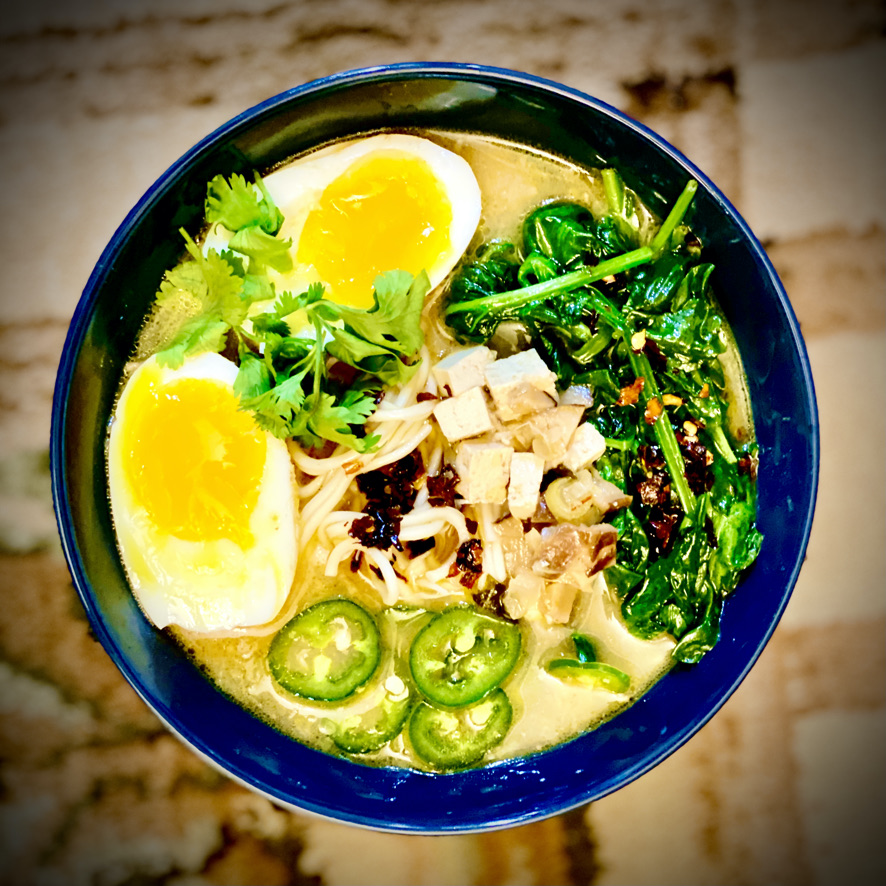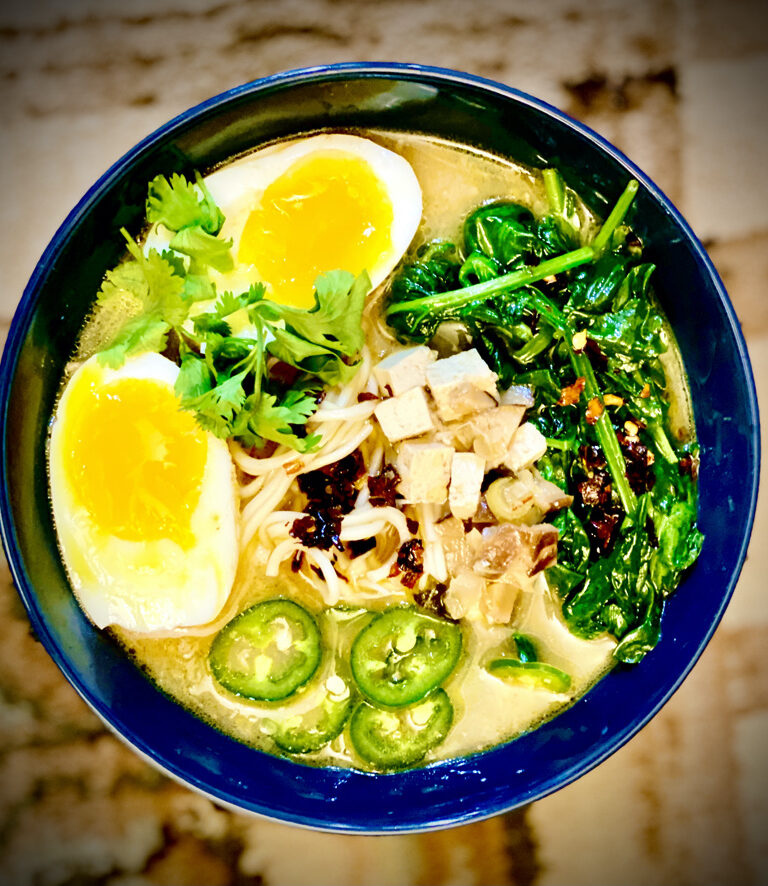Ramen is a Japanese noodle soup. I am sharing a vegetarian version of Ramen that brings out a rich umami flavor with protein rich ingredients.Traditional Ramen recipes consist of wheat noodles served in a meat /fish-based broth, flavored with soy sauce or miso, and toppings such as meats, nori (dried seaweed), scallions, tofu etc.
My first experience of eating Ramen was at a “Wagamama” restaurant in New York city. I also had Ramen at “Wagamama” in London. Since then I wanted to learn how to make Ramen at home. The simplicity of the dish with a feel-good comfort and a complete meal all in a single bowl make Ramen an appealing food. I have adapted the recipe to bring out a combination of tastes and ingredients that are not common in the traditional Ramen recipes. Hope you will enjoy the variation.
A Ramen bowl has three main parts : (1) Ramen noodles (2) Ramen soup (3) Toppings
- Ramen noodles : The main ingredient that separates Ramen noodles from other types of wheat noodles is kansui – a type of alkaline mineral water. I have tried to substitute ramen noodles with Udon noodles and hakka noodles. The taste and texture of the noodles vary and if you are not very particular about the original taste of Ramen noodles, then substitutes are fine.
- Ramen soup : I have created a miso based soup for my ramen soup. My recipe is adapted from the traditional Japanese recipe where I have eliminated the fish based ingredients to make it suitable for Vegans and vegetarians. I have also enriched the flavors with some ingredients that are not used in the traditional recipe.Miso soup is low-calorie, high-protein and nutrient-rich as it combines some key ingredients that are known for their nutritional value, such as miso paste and dashi ( broth made with shiitake mushrooms). I have customized the basic recipe for miso soup by adding ginger, garlic, onion, cabbage, soy sauce and rice wine vinegar. The added ingredients enhance the flavor profile of the traditional miso soup to a richer umami flavor. The secret to a good vegetarian Ramen soup lies in two main ingredients :
- (a)Miso paste – Miso paste is made from fermenting soybeans with salt and koji (a mold). Miso paste contains probiotics created during the fermentation process – a healthy bacteria which can boost immunity and gut health. Miso paste is available in most grocery stores. To retain the good taste and health value of miso paste, we should add it to the soup just before removing from the heat (do not boil the soup after adding the miso paste).
- (b) Dashi – A type of stock used as a base in many Japanese foods. There are multiple variants of dashi based on the ingredients used. To make vegetarian dashi stock – we can either use kombu (kelp – a type of seaweed) or Shiitake mushrooms. I have used dried shiitake mushrooms to make shiitake dashi. I used store-bought dried shiitake mushrooms, and soaked them to extract the juices. The extracts from shiitake mushrooms gives a perfectly balanced umami flavor that made my soup almost as good as any restaurant quality miso soup.
- Toppings : My recipe includes toppings of Nori (a dried edible seaweed used in Japanese cuisine, made from red algae that is often used in sushi), tofu, semi-boiled eggs, spring onions, sauteed spinach, fresh cilantro, thinly sliced Jalapenos and a touch of chili oil (optional).
Ramen is best eaten when it is steaming hot. You can keep the ramen soup prepared and assemble the Ramen bowl when you are ready to serve.
I hope you will find this recipe helpful and tasty. Please rate this recipe. If you have liked it, please share it with your friends. For more updates on new recipes, please subscribe.

Ramen bowl recipe for vegetarians – with a savory touch
Description
Traditional Japanese noodle soup recipe that combines the umami flavors with the warm spicy flavors of ginger and garlic - making it perfect digestive food
Ingredients
Main ingredients for the Ramen noodle soup
Optional - Chili oil for topping
Instructions
-
Boil the Ramen noodles
- Fill a medium saucepan with water until it is 1/2 full. The size of saucepan must be large enough so that noodles are completely submerged in water.
- Bring the water to boil.
- Add the ramen noodles. Let the noodles boil for 4 minutes. Stir couple of times so that the noodles boil uniformly.
- Remove from heat and strain the water.
-
Prepare the Dashi broth
- You may use fresh shiitake mushrooms. Alternatively, you can use the dried mushrooms by following the below steps :
- Wash the dried shiitake mushrooms
- Bring the water to boil in a separate pan.
- Turn off the heat. Add the mushrooms and let them soak in the water.
- Keep the mushrooms in the water for at least an hour (it is ok to soak overnight for better flavor)
- After the mushrooms have soaked, filter the liquid. This is the shiitake dashi stock.
- Chop the mushrooms into small pieces as they can be used in the soup.
-
Prepare the vegetables
- Chop finely the onion and cabbage
- Grate the ginger and garlic
- Separate the green and white parts of the spring onion. Cut each part into thin rings. We will use the green part for garnish and the white part in the soup base.
- Cut the nori sheets into thin strips using a scissor
- Clean the spinach and dry the leaves completely
-
Prepare the soup base
- Place a sauce pan on the stove and add the oil
- When the oil is hot, add the onion, ginger and garlic. Stir for about a minute on medium heat.
- Add the chopped mushrooms, cabbage, and white onions. Stir for another 3-4 minutes.
- Add Soy sauce, rice wine vinegar and salt. Stir well.
- Add the dashi stock and bring the mixture to boil.
- Remove from heat after about 10 minutes of boiling
-
Add the miso paste
- Take about half cup of hot soup in a separate bowl
- Add the miso paste and mix it well so that the mixture forms a slurry
- Add this miso slurry back to the bowl of soup and mix well.
-
Saute the toppings
- Squeeze the water from tofu and cut into into small cubes of about ½-¾ inch. Use a paper or cloth towel to absorb the remaining water from the tofu as we want our tofu to be as dry as possible
- Take a saute pan and add about 1 tablespoon of cooking oil. Stir fry the Tofu on high heat until the tofu cubes turn light brown and crispy. Remove the fried tofu in a bowl
- Using the same saute pan and the remaining oil, saute the spinach. The spinach leaves will soften and get cooked in about 2 minutes. Remove the spinach from the pan as soon as the leaves have softened. Do not wait until the leaves start to turn dark.
-
Boil the eggs - Watch this step
- To get perfect eggs for Ramen, we need the yolk to be like custard or runny depending on your preference.This is a delicate step that needs to be timed correctly.
- The eggs should be at room temperature.
- Fill a saucepan with water until ¾ of the pan is full and bring it to boil
- Add the eggs when the water comes to full boil and reduce the heat to medium
- To get runny yolk : Let the eggs boil for about 7 minutes
- To get custard like yolk : Let the eggs boil for 9-10 minutes but not longer.
- Remove the eggs from the boiling water and immerse them in a bowl filled with ice water. This will stop the cooking process.
- After about 5 mts, remove the shells. Cut the eggs vertically in halves.
-
Preparing the Chili oil
- Take a heat resistant glass bowl and add the crushed red pepper, grated ginger, garlic and salt
- Take a small frying pan about 4-6 inches wide and at least 2 inches deep. Add the cooking oil. Turn the heat on keep it on medium flame.
- After about a minute, test the temperature by adding a couple of crushed pepper flakes. If you see immediate bubbling, it means that oil is ready. remove the pan from heat. If you don't see immediate bubbles on adding the pepper flakes, let the oil heat for another minute.
- We want the oil to be hot enough to fry the ingredients but not burn them
- Slowly pour the hot oil into the other bowl containing crushed pepper and other ingredients.
- Stir slowly. Add the sesame oil after couple of minutes when the oil has cooled a little.
- Chili oil is ready
-
Serving the Ramen noodle bowl
To serve the Ramen :
- Take a Ramen bowl
- Add the boiled ramen noodles in the desired quantity
- Pour boiling hot Ramen soup over the noodles, until the noodles are covered in the soup.
- Garnish with all the toppings (boiled eggs, fried tofu, Jalapenos, spinach, cilantro and chili oil)
- Add a touch of chili oil (only if you desire a spicy flavored ramen)
Notes
- Make sure to add the miso paste after the boiling is done and the soup is removed from heat. This will help protect the probiotic value of the fermented miso paste.
- If you would like the miso soup to be prepared in advance and stored in the refrigerator, complete all the steps except adding the miso paste. When you are ready to eat, the miso paste can be added after the soup has been heated.
- Observe the cooking times for boiled eggs and ramen noodles to get the correct consistency of yolk and texture of noodles


